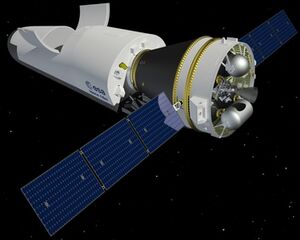Engineering:Space Rider
 Artist's rendering of Space Rider spaceship | |
| Names | Space Reusable Integrated Demonstrator for Europe Return [2] |
|---|---|
| Mission type | Reusable spaceplane |
| Operator | ESA |
| Website | m |
| Mission duration | 60 days (planned) |
| Spacecraft properties | |
| Spacecraft | Space RIDER |
| Spacecraft type | Lifting body spaceplane |
| Manufacturer | Avio and Thales Alenia Space[1] |
| Launch mass | Approx. 4900 kg (Full stack AOM + RM, including fluids and propellants)[1] |
| Landing mass | up to 2850kg[1] |
| Payload mass | 600 kg (1,300 lb)[1] |
| Dimensions | Length: 8.044 m (26.39 ft) (Full stack AOM + RM)[1] |
| Power | 600 watts[3] |
| Start of mission | |
| Launch date | Q3 2025 (planned)[4] |
| Rocket | Vega-C |
| Launch site | Guiana Space Centre |
| Contractor | Arianespace |
| End of mission | |
| Landing site | Guiana Space Centre[1] |
| Orbital parameters | |
| Reference system | Geocentric |
| Regime | Low Earth orbit |
The Space Rider (Space Reusable Integrated Demonstrator for Europe Return) is a planned uncrewed orbital lifting body spaceplane aiming to provide the European Space Agency (ESA) with affordable and routine access to space.[5][6][7] Contracts for construction of the vehicle and ground infrastructure were signed in December 2020.[8] Its maiden flight is currently scheduled for the third quarter of 2025.[4]
Development of Space Rider is being led by the Italian Programme for Reusable In-orbit Demonstrator in Europe (PRIDE programme) in collaboration with ESA, and is the continuation of the Intermediate eXperimental Vehicle (IXV) experience,[2][9] launched on 11 February 2015. The cost of this phase, not including the launcher, is at least US$36.7 million.[10] At the ESA Ministerial Council held in Seville in November 2019, the development of the Space Rider was subscribed by the participating member states with an allocation of €195.73 million.[11]
History
The European Space Agency has a program called Future Launchers Preparatory Programme (FLPP), which made a call for submissions for a reusable spaceplane.[12] One of the submissions was by the Italian Space Agency, that presented their own Programme for Reusable In-orbit Demonstrator in Europe (PRIDE programme) which went ahead to develop the precursor called Intermediate eXperimental Vehicle (IXV) and the resulting Space Rider.[2]
Funding was initially approved by the ESA in 2016, with the project to be led by the Italian Aerospace Research Centre (CIRA).[10] Thales Alenia Space and Lockheed Martin were tasked with completing the design by 2019. In November 2017, the ESA approved funding to Thales Alenia Space and Avio to build reentry and service modules, respectively.[13] In late November 2019, the project was fully approved by ESA and will be funded mostly by Italy,[14][15] and in December 2020, ESA signed contracts with co-prime contractors Thales Alenia Space and Avio for delivery of the Space Rider flight model, which in turn manage a consortium of more than 20 European companies operating in the space sector.[2] The Italian Space Agency (ASI) subsequently contracted with Virgin Galactic for a suborbital research flight on SpaceShipTwo for research related to Space Rider.[16] The first flight of Space Rider is currently scheduled for the third quarter of 2025.[4]
In April 2018, ESA released an Announcement of Opportunity (AoO) to fly small payloads on Space Rider's maiden flight.[17] By June 2019, the project was advancing towards the Critical Design Review (CDR) at the end of 2019.[7] An industrial reorganisation followed the ESA Ministerial Council held in 2019. To deal with it a design bridging phase was put in place with the System CDR planned in mid-2022.[1]
On completion of the two-month long maiden mission, Space Rider will return to Earth with the payloads stowed in its cargo bay.[17] This qualification flight of Space Rider will take place in 2025[4] followed by several missions to demonstrate a range of capabilities and orbits, before handing over the project to the private sector.[18]
By 2025, the ESA plans to privatise the Space Rider, with Arianespace the likely operator.[19]
On June 20 2023, the Space Rider programme proceeded into Phase D of its development, allowing qualification and production to commence. [20]
Design
The Space Rider design inherits technology developed for the earlier Intermediate eXperimental Vehicle, also within the Programme for Reusable In-orbit Demonstrator in Europe (PRIDE).[2][10][13] The design team considered the trade-offs of using only a lifting body and also using optional wings or vertical fins.[9] It was then decided in 2017 that the design should optimise the internal volume of the Vega rocket fairing, so its aerodynamic shape will be a simple lifting body, as tested on its predecessor, the IXV.[9] 3-axis control is achieved by the use of rear flaps.[9]
Space Rider will have the potential to allow experiments in microgravity, such as exposure of materials to outer space and in-orbit validation of technologies, as well as deployment of small satellites.[17]
In 2019, some parafoil guided landing tests will[needs update] be performed by dropping a full-scale model from helicopters or balloons.[10]
Space Rider is designed to launch atop the Vega-C launch vehicle from Guiana Space Centre.[4]The spacecraft is being designed to conduct missions up to two months long in low Earth orbit with up to 600 kg[1] of cargo.[3][21] The re-entry module itself is a testbed for entry technologies as the IXV precursor was, so future improvements are envisioned,[22] including point-to-point flights, even "space tourism".[10]
Activities for Phase-B2/C, covering the Preliminary Design Review (PDR) started on 25 January 2018,[23] and the Critical Design Review (CDR) begin in late 2019.[7] An industrial reorganisation followed the ESA Ministerial Council held in 2019. To deal with it a design bridging phase was put in place with the System CDR planned in mid-2022.[1]
Service module
Space Rider's service module is a modified version of the Vega-C AVUM+, which will extend the time that can be spent in orbit by at least two months before Space Rider returns with its cargo to Earth to land on the ground.[24] The service module will provide power, attitude control and deorbit capability, and it will separate from the spacecraft just before atmospheric reentry.[7]
Landing
Upon atmospheric entry, the lifting body shape will decelerate the spacecraft to subsonic speed (below Mach 0.8), when one or two drogue parachute will be deployed at about 15–12 km altitude to slow it further (to Mach 0.18 - 0.22)[21] Then, a controllable gliding parachute called parafoil will be deployed to begin the controlled descent phase for a nearly horizontal touchdown (≈35 m/s) using no wheels.[21] The landing concept is similar to the NASA X-38 landing system.[21]
The baseline landing site is the Guiana Space Centre.[1] For orbits with inclination >37°, landings could be performed at the Portuguese Santa Maria Island in the Azores archipelago.
Preliminary specifications
| Space Rider | Parameter/units |
|---|---|
| Crew | None (robotic only) |
| Length | ≥ 8.044 m (26.39 ft)[1] |
| RM Length | ≥ 4.6 m (15 ft)[1] |
| AOM Length | ≥ 3.5 m (11 ft)[1] |
| Payload volume | ≥ 1.2 m3 (1200 liters) |
| Mass | Max. 4,900 kg (10,800 lb)[1] |
| Payload mass | 620 kg (1,370 lb)[1] |
| Flight time | At least 60 days[24] |
| Landing mass | 2,850 kg (6,280 lb)[1] |
| Landing accuracy | 150 m [21] |
| Landing speeds | Horizontal: 35 m/s; vertical: 3 m/s [21] |
| Parachute deployment shock | < 4 g[21] |
| Power | 600 watts[3] |
| Reusability | 6 flights [3] |
| Turnaround time | <6 months [3] |
See also
- Boeing X-37, a winged spaceplane by the U.S. Air Force
- Dream Chaser, a private lifting body spaceplane
- Hermes (spaceplane), CNES/ESA spaceplane concept from 1975
- SUSIE, a 2022 ArianeGroup proposal for a reusable, crewed, spacecraft
- List of spaceplanes
References
- ↑ 1.00 1.01 1.02 1.03 1.04 1.05 1.06 1.07 1.08 1.09 1.10 1.11 1.12 1.13 1.14 1.15 1.16 Parsonson, Andrew (14 February 2022). "ESA Space Rider update from programme manager Dante Galli". https://europeanspaceflight.com/esa-space-rider-update-from-programme-manager-dante-galli/.
- ↑ 2.0 2.1 2.2 2.3 2.4 Space RIDER PRIDE Italian Aerospace Research Centre (CIRA) Accessed: 15 November 2018
- ↑ 3.0 3.1 3.2 3.3 3.4 "SPACE RIDER". ESA. https://esamultimedia.esa.int/docs/space_transportation/Space_Rider_factsheet_HiRes_ok.pdf.
- ↑ 4.0 4.1 4.2 4.3 4.4 Richards, Bella (26 August 2023). "ESA's Space Rider likely to launch third quarter of 2025, program manager says". NASASpaceFlight. https://www.nasaspaceflight.com/2023/08/space-rider-update/.
- ↑ "Space Rider". ESA. https://www.esa.int/Enabling_Support/Space_Transportation/Space_Rider.
- ↑ ESA's reusable Space RIDER capsule would carry equipment to orbit and back Michael Irving, New Atlas 6 June 2019
- ↑ 7.0 7.1 7.2 7.3 "Space Rider: Europe's reusable space transport system". ESA. 5 June 2019. https://www.esa.int/Enabling_Support/Space_Transportation/Space_Rider_Europe_s_reusable_space_transport_system.
- ↑ "ESA signs contracts for reusable Space Rider up to maiden flight". ESA. 9 December 2020. https://www.esa.int/Enabling_Support/Space_Transportation/Space_Rider/ESA_signs_contracts_for_reusable_Space_Rider_up_to_maiden_flight.
- ↑ 9.0 9.1 9.2 9.3 Aeroshape Trade-Off and Aerodynamic Analysis of the Space RIDER Vehicle M. Marini, M. Di Clemente, G. Guidotti, G. Rufolo, O. Lambert, N. Joiner, D. Charbonnier, M.V. Pricop, M.G. Cojocaru, D. Pepelea, C. Stoica, and A. Denaro, 7th European Conference for Aeronautics and Space Sciences (EUCASS) 2017
- ↑ 10.0 10.1 10.2 10.3 10.4 Coppinger, Rob (11 April 2017). "The reusable spaceplane launched inside a rocket". BBC. http://www.bbc.com/future/story/20170411-the-reusable-spaceplane-launched-inside-a-rocket.
- ↑ DLR (28 November 2019). "Launcher Programme Subscription". DLR Countdown Newsletter Special Edition: 43. https://www.dlr.de/rd/PortalData/28/Resources/dokumente/publikationen/countdown/Countdown39_hires.pdf.
- ↑ New milestone in IXV development ESA 15 September 2010
- ↑ 13.0 13.1 Henry, Caleb (30 November 2017). "ESA pours US$107 million into Vega E and a reusable spaceplane". SpaceNews. http://spacenews.com/esa-pours-107-million-into-vega-e-and-a-reusable-spaceplane/.
- ↑ Italy satisfied with outcome of ESA ministerial Jeff Foust, SpaceNews 29 November 2019
- ↑ Europe gives space programs a big boost Daniel Clery, Science 28 November 2019
- ↑ Foust, Jeff (19 December 2017). "Virgin Galactic signs SpaceShipTwo research flight deal with Italian space agency". SpaceNews. http://spacenews.com/virgin-galactic-signs-spaceshiptwo-research-flight-deal-with-italian-space-agency/.
- ↑ 17.0 17.1 17.2 Messier, Doug (12 April 2018). "Announcement of Opportunity to Fly Payloads on ESA's Space RIDER". Parabolic Arc. http://www.parabolicarc.com/2018/04/12/announcement-opportunity-fly-payloads-esas-space-rider/.
- ↑ ESA targets 2021 for Space RIDER demo flight Tereza Pultarova, SpaceNews 13 November 2018
- ↑ Coppinger, Rob (22 June 2017). "ESA aims to privatize Space RIDER unmanned spaceplane by 2025". SpaceNews. http://spacenews.com/esa-aims-to-privatize-space-rider-unmanned-spaceplane-by-2025/.
- ↑ Parsonson, Andrew (20 July 2023). "ESA's Space Rider Spacecraft Reaches Key Milestone". https://europeanspaceflight.com/esas-space-rider-spacecraft-reaches-key-milestone/.
- ↑ 21.0 21.1 21.2 21.3 21.4 21.5 21.6 Conceptual Design of the Descent Subsystem for the Safe Atmospheric Re-Entry Flight of Space RIDER doi:10.13009/EUCASS2017-624 Alessandro Balossino, Luciano Battocchio, Matteo Giacci, Giuseppe Guidotti, Giuseppe Rufolo, Angelo Denaro, Nicola Paletta, Centro Italiano Ricerche Aerospaziali 2017
- ↑ Mission and GNC Challenges from IXV to Space RIDER Rodrigo Haya Ramos, Davide Bonetti, Research Gate Conference: Fourteenth International Planetary Probe Workshop, The Hague, The Netherlands June 2017
- ↑ Space RIDER Gunter's Space Page
- ↑ 24.0 24.1 Focus on Vega developments European Space Agency Published by PhysOrg on 26 November 2018
 |


